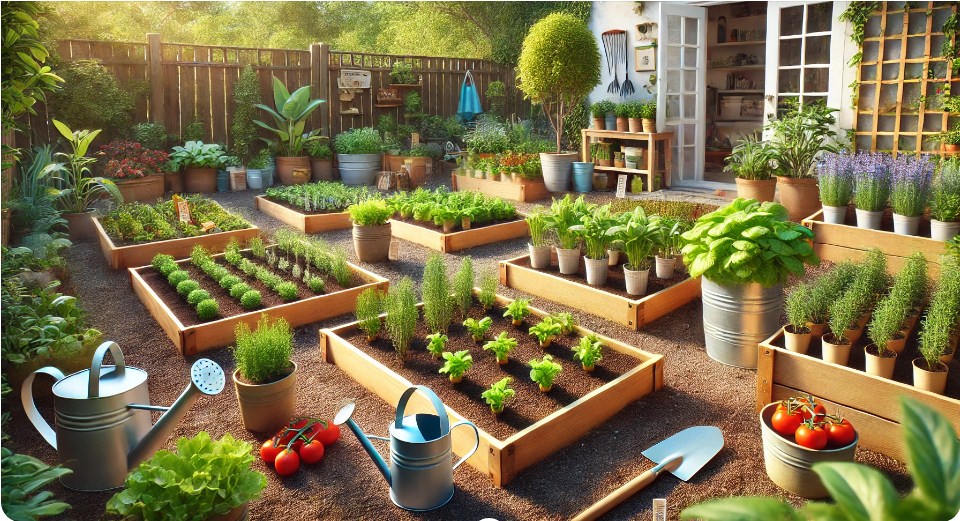Starting a garden at home can be one of the most fulfilling and therapeutic hobbies you’ll ever take on. Whether you have a large backyard or a small balcony, there’s always space to grow something green. If you’re a beginner and feel overwhelmed, don’t worry—you’re not alone. With the right tips and mindset, gardening can be simple and incredibly rewarding.
Let’s walk through the essential steps to help you start your own home garden from scratch, even if you’ve never touched a shovel before.
Understand Your Gardening Space
Before you plant anything, it’s crucial to get familiar with your gardening area. Whether it’s a sunny windowsill, a balcony, or a backyard, the space you have will influence what and how you grow.
Evaluate Sunlight
Spend a day observing how much sunlight your space gets. Some plants require full sun (6–8 hours of direct light), while others thrive in partial shade. This will help determine what kinds of plants will succeed in your garden.
Know Your Climate Zone
Your climate plays a big role in gardening success. Use USDA Plant Hardiness Zone maps (or similar if you’re outside the U.S.) to find which plants grow well in your area. This avoids disappointment and wasted effort.
Check Soil Quality (If Applicable)
If you’re planting directly in the ground or using raised beds, test the soil. Most garden centers sell soil test kits, or you can send a sample to your local extension service. Good soil should have a balance of nutrients and proper drainage.
Choose the Right Type of Garden
Gardens come in many forms. Choose one that fits your lifestyle and space.
-
Container Garden – Ideal for small spaces or balconies.
-
Raised Bed Garden – Perfect for those who want control over soil quality.
-
In-Ground Garden – Best for larger outdoor areas with good soil.
-
Vertical Garden – Great for maximizing space using walls or trellises.
Pick the Right Plants for Beginners
When starting out, choose plants that are low-maintenance and easy to grow. This helps build your confidence and minimizes frustration.
Great Plants for Beginners:
-
Herbs: Basil, mint, rosemary, chives
-
Vegetables: Lettuce, radishes, green beans, cherry tomatoes
-
Flowers: Marigolds, sunflowers, zinnias, pansies
-
Houseplants: Pothos, spider plant, peace lily, snake plant
Start with a few plants and expand as you learn more.
Gather the Basic Gardening Tools
You don’t need a shed full of tools to begin, but a few essentials will make gardening much easier:
-
Gardening gloves
-
Trowel (for digging small holes)
-
Pruners (for trimming)
-
Watering can or hose with a spray nozzle
-
Garden fork or hand rake
-
Plant labels (optional but helpful for keeping track)
Invest in decent-quality tools—they last longer and are more comfortable to use.
Prepare the Soil or Containers
If you’re planting in containers, make sure they have proper drainage holes. Use high-quality potting mix, not garden soil, for best results.
For in-ground or raised bed gardens, add compost or organic matter to enrich the soil. Turn the soil using a garden fork and remove weeds or debris.
Proper soil preparation is key to plant health and productivity.
Start Planting
When you’re ready to plant:
-
Follow Instructions: Each plant has its own spacing, depth, and watering needs. Always check seed packets or plant labels.
-
Group by Needs: Plant similar species together based on their sun and water requirements.
-
Don’t Overcrowd: Give each plant space to grow. Overcrowding leads to competition and disease.
-
Water Properly: Water deeply but not too often. Let the top inch of soil dry out between waterings.
Learn About Plant Care and Maintenance
Once your garden is planted, it’s not a “set and forget” project. Daily and weekly care keeps plants healthy and productive.
Key Maintenance Tasks:
-
Watering: Check moisture levels regularly.
-
Weeding: Remove weeds promptly to reduce competition.
-
Pruning: Trim dead leaves and spent flowers.
-
Fertilizing: Use organic compost or a balanced fertilizer every few weeks.
Gardening is a rhythm—you’ll get into a routine as you go.
Deal With Common Gardening Challenges
Even experienced gardeners face setbacks. Here are a few common problems and how to handle them:
Pests
Look for holes in leaves, sticky residue, or insects. Try these solutions:
-
Use neem oil or insecticidal soap.
-
Introduce beneficial insects like ladybugs.
-
Plant pest-repelling herbs like basil or marigold.
Diseases
Fungal diseases can spread quickly. To prevent:
-
Water at the base, not on leaves.
-
Avoid overcrowding plants.
-
Remove affected leaves immediately.
Poor Growth
This could be due to low nutrients, insufficient sunlight, or overwatering. Adjust one factor at a time and monitor progress.
Keep Learning and Expanding
Gardening is a journey, not a destination. The more you learn, the better you get. Here are some ways to grow your knowledge:
-
Join local gardening groups or online forums.
-
Follow gardening YouTube channels or blogs.
-
Keep a gardening journal to track what works and what doesn’t.
-
Try growing new types of plants each season.
Why Gardening Is Worth It
Beyond the fresh produce and beautiful blooms, gardening offers:
-
Stress relief and mental clarity
-
A way to connect with nature
-
Better air quality in and around your home
-
Physical activity and improved health
-
A sense of accomplishment and pride
It’s a simple yet powerful habit that can enrich your life.
Final Thoughts: Your Garden, Your Sanctuary
Starting a home garden from scratch may seem intimidating, but it’s really about taking small, consistent steps. Begin with easy plants, learn through trial and error, and soon your garden will be blooming—not just with plants, but with joy and peace.
Let your garden be a reflection of your personal care and patience. No matter how small it is, it has the power to transform your space—and you.
